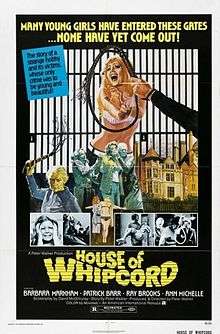House of Whipcord
| House of Whipcord | |
|---|---|
 | |
| Directed by | Pete Walker |
| Produced by | Pete Walker |
| Written by | David McGillivray |
| Story by | Pete Walker |
| Starring |
Barbara Markham Patrick Barr Ray Brooks Ann Michelle Sheila Keith |
| Music by | Stanley Myers |
| Cinematography | Peter Jessop |
| Edited by | John Black |
Production company |
Peter Walker (Heritage) Ltd. |
Release dates | 19 April 1974 |
Running time | 102 mins. |
| Country | United Kingdom |
| Language | English |
House of Whipcord is a 1974 horror exploitation film directed by Pete Walker.[1] It was his first collaboration with former Time Out critic and screenwriter David McGillivray, who went on to write a further three films for him.[2] It also marked the horror film debut of distinguished character actress Sheila Keith, who went on to star in four more films for Walker. "House of Whipcord" opens with the ironic credit: "This film is dedicated to those who are disturbed by today's lax moral codes and who eagerly await the return of corporal and capital punishment".[3]
Plot
The film opens with a semi-nude young woman running down a highway and being picked up by a trucker.
While at a party, French model Anne-Marie DeVarnet (Penny Irving) is shocked to see her photographer/boyfriend has put on display a recently shot photo where she is seen being arrested by police, for public nudity. Humiliated, Anne-Marie dumps her boyfriend and finds comfort in a party-goer named Mark E. Desade (Robert Tayman), who offers to take her to his country estate to escape the scandal her ex-boyfriend has caused her.
Unfortunately, Anne-Marie discovers that Mark E. Desade (whose name shares the same pronunciation as the infamous Marquis de Sade) is a procurer for his sadistic ex-reform school matron mother, Margaret (Barbara Markham). Years earlier, Margaret was brought to trial when her corrupt reign over the reform school she worked at, led to a young French girl under her charge to kill herself (in truth, Margaret murdered her and made it look like a suicide). Found not guilty but fired from her job, she seduced the High Court Judge who heard her case (Patrick Barr). The judge left his wife for Margaret, who bore him a son (Mark) and who worked with her to turn his mansion home into a secret illegal prison for delinquent women. However, the now retired judge (blind and senile), is oblivious to the fact that his wife is now using the prison to torture and ultimately execute women, upon them gaining three demerits during their stay.
Anne-Marie falls foul of Margaret's cruelty, as she reminds the evil warden of the charge she killed and whose death cost her her job. Meanwhile, Anne-Marie's friend finds Mark, who has discovered his mother's murderous deeds at the prison after watching his mother's minions dispose of a corpse of a prisoner.
In the end, Anne-Marie escapes, is recaptured, and then hanged after earning a third demerit. Her friends find her prison, and as the police search for their way in, Mark is killed by his mother, who kills herself in remorse with the same noose she set up for Anne-Marie. The judge and his wife's henchwomen are arrested, and the prisoners are freed, shown being taken to hospital.
Critical reception

Allmovie called it a "disturbingly effective horror film", writing that "Many viewers will be offended by the film's repressive right-wing tone, but its genuine scares and creepy atmosphere will outweigh its philosophical offenses for most horror fans."[4]
The influential Halliwell's Film Guide described the film as a "low budget psychological horror that stylishly achieves its object: to disturb", and quotes Derek Elley in Films and Filming: "Shows that something worthwhile in the entertainment-horror market can be done for the tiny sum of £60,000".
David Pirie wrote in Time Out: "An above average sexploitation/horror that has been put together with some polish and care from a fairly original script. The film is dedicated ironically to all those who wish to see the return of capital punishment in Britain, and it's about a senile old judge and his wife who are so appalled by current permissiveness that they set up a gruesome house of correction for young girls. The only trouble is that the film undercuts its potentially interesting Gothic theme by some leering emphases, and the final result is likely to be seen and appreciated only by the people who will take the dedication at its face value."[5]
Cast
- Barbara Markham ... Mrs. Wakehurst
- Patrick Barr ... Justice Bailey
- Ray Brooks ... Tony
- Ann Michelle ... Julia
- Sheila Keith ... Walker
- Dorothy Gordon ... Bates
- Penny Irving ... Ann-Marie Di Verney
- Robert Tayman ... Mark E. Desade
- Ivor Salter ... Jack
- Karan David ... Karen
- Celia Quicke ... Denise
- Ron Smerczak ... Ted
- Tony Sympson ... Henry
- Judy Robinson ... Claire
- Jane Hayward ... Estelle
- Celia Imrie ... Barbara
- Barry Martin ... Al
- Rose Hill ... Henry's Wife
- Dave Butler ... Ticket Collector
References
- ↑ "House of Whipcord". BFI.
- ↑ "BFI Screenonline: Walker, Pete (1939-) Biography". Screenonline.org.uk. Retrieved 2014-02-23.
- ↑ James Gracey (2009-10-19). "Behind the Couch: House of Whipcord". Watchinghorrorfilmsfrombehindthecouch.blogspot.co.uk. Retrieved 2014-02-23.
- ↑ Robert Firsching. "House of Whipcord (1975)". Allmovie. Retrieved 20 June 2012.
- ↑ "Time Out (London): House of Whipcord review". Time Out London.
External links
- House of Whipcord at the Internet Movie Database
- House of Whipcord at AllMovie
- Chibnall, Steve (1998). Making Mischief: The Cult Films of Pete Walker. FAB Press.
- Rigby, Jonathan (2000). English Gothic: A Century of Horror Cinema. Reynolds & Hearn.
- Hodgkinson, Will (10 March 2005). "'God, What a Terrible Film'". The Guardian. Retrieved 8 January 2014.